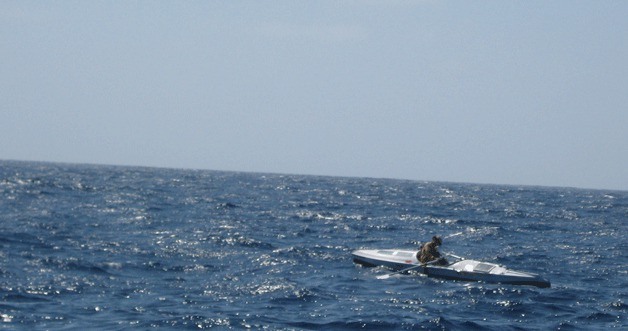It was still dark when fisherman Adi Ljubovic headed into the choppy waters far off San Diego, Calif. Yet even in the dim morning hours he could see something directly ahead of him. But what could it be?
“You always need to be well aware of other lights on the water,” Ljubovic said in an email to The Review. “The white lights are usually the back, anchor lights of other fishing boats going toward the fishing grounds.”
Ljubovic likes to keep a safe distance from other boats in the water, but he was fast approaching one mysterious and unusual light in the water.
“I realized I was getting closer to him,” Ljubovic said. “His light was strange — seemed bigger than a boat light, and it was closer to the water. I had to take my boat out of gear so I didn’t run him over.”
Slowly, the fisherman passed some kind of vessel in the dark waters.
“I thought I saw what looked like rows on the side,” he added “But I ruled that out as we were good 30 miles down south — about 15 out from Mexican coast.”
Oars, however, are exactly what Ljubovic saw. It was Bainbridge Island teacher Rory Wilson on his way to Hawaii in KROS, his self-designed vessel powered by rowing and kites.
Wilson is currently rowing, and using wind power, to travel across the Pacific Ocean to Hawaii.
Ljubovic stopped and briefly peering into the dark. But since he was so close to the border, he figured he should avoid any curious vessels in the dark.
“Thinking it may be some illegal activity, we continued on our way,” he said.
Ljubovic spent the day reeling in tuna from the sea, 70 miles offshore. On his way back, he got a better look at the mysterious vessel from that morning.
“That was about 50 miles down south,” Ljubovic said. “We saw him from the distance, and went toward him.”
The fisherman got within yelling distance of Wilson. He could see that the mysterious boat was not a drug smuggling operation, but rather, a 21-foot custom-designed rowing vessel that was heading further out into the sea.
Their encounter was brief.
Ljubovic offered Wilson some fish, but Wilson turned it down — which makes sense. Wilson doesn’t have any cooking gear on KROS. Instead, he developed his own food supplement to take care of his dietary needs. In fact he incorporated his diet into his classroom projects. Island students calculated out how much calories, protein and other nutrients Wilson needs to keep rowing.
Wilson gets his water from the sea around him, through a desalination unit.
When Ljubovic crossed paths with Wilson, he was just beginning his Pacific journey in late September.
Wilson is now much farther along — approximately 218 nautical miles from his destination. He expects to arrive in Hawaii around Nov. 1. At his current speed, he could complete the journey in under 45 days, making his trip among the shortest for a vessel of its kind.
Of course, Wilson isn’t relying upon rowing alone, as others have done in the past for such a journey. He is also using kites to harness winds that will carry him forward.
“He’s been making about 70 to 80 nautical miles a day,” said Shane Wilson, Rory’s brother who has been keeping in contact with the island teacher during his great sea journey.
To put that number in perspective, a nautical mile is equal to about 1.15 regular miles.
“It’s surprising to see how many miles he’s been able to make,” Shane Wilson said. “He’s been getting winds between 10 and 20 knots. It’s been a little lighter than he thought it would be.”
The boat itself is also a bit different from what Wilson had expected.
“He has not gotten used to how extreme the boat is; it’s a lot to handle,” Shane said. “It surprised him at how physical a boat it is.”
On KROS, there is always something to do. Wilson said that his brother can put in 18 to 20 hour days sometimes.
“He’s active all the time, he’s rowing the boat or flying the kites or adjusting the rudder,” Wilson said. “Sliding in and out of his sleeping compartment is difficult, and you’re doing that while the boat is bouncing around, there is no relaxation on that boat whatsoever. It’s kind of like taking a surf board to Hawaii. It’s so small.”
“I think he’ll probably be pretty glad to land in Hawaii and relax for a while,” he added. “It’s been a solid six weeks of work for him. But I think he thought there would be more idle time in the ocean, and there just hasn’t been.”
When Rory Wilson lands on the island of Oahu, he will have to make a decision: Head south and island hop and return to the Pacific Coast that way, or head north and try to catch the winds there to make his return.
Whatever he decides, he’s already made an impression along the way.
“Taking a trip to Hawaii on a kayak is just an amazingly brave idea,” Ljubovic said. “I am a kayak fisherman, I’ve been out on a kayak on some rough seas — not fun! I hope he makes it to Hawaii safe.”



